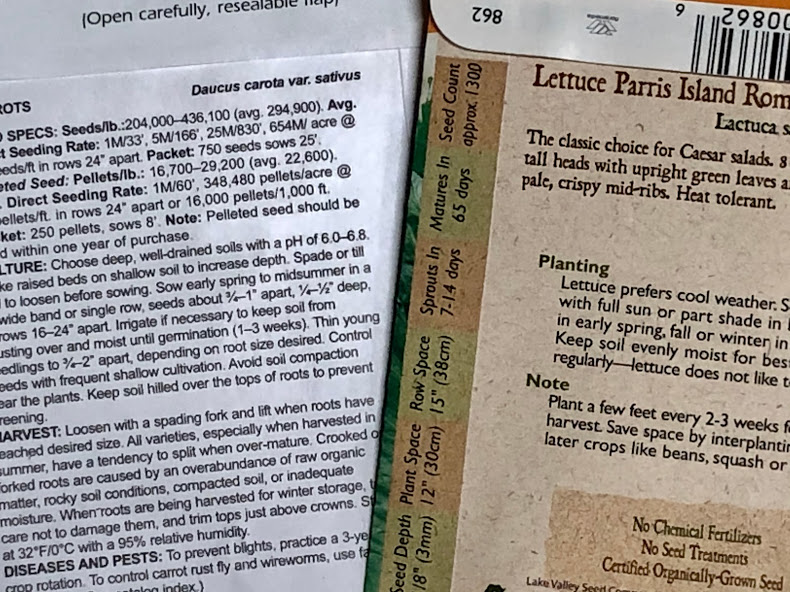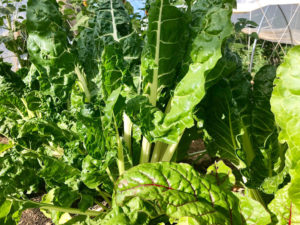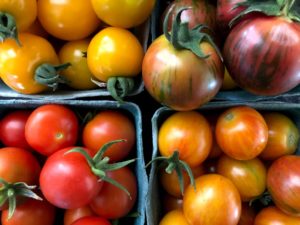Questions to get you started
After you’ve determined your goals for gardening and mapped out your space, you arrive at the fun (but overwhelming!) process of picking out seeds. There are so many factors to consider when selecting seeds and so many companies vying for your attention. So before you ever even go into the store or open the browser on your computer, take a few minutes to think about these questions.
First, what type of seed are you looking for – conventionally grown? non-GMO? organic? heirloom? open-pollinated? Typically when you are purchasing seeds the price difference between conventionally grown and organically grown seeds is so minimal, I highly encourage everyone to buy the organic seeds whenever possible. This gives you peace of mind that no harsh chemicals or pesticides were used on the plants and by default they are non-GMO (meaning the seeds have not been genetically modified). If you are hoping to save seeds at the end of the growing season to use for next year’s crop you also need to be sure you are selecting an open-pollinated variety. This means the seeds you save will be true to the variety and characteristics you’re hoping for. If you use a hybrid seed saved from a previous year there’s no telling which characteristics will come out and it might not produce a desirable outcome! We also love using heirloom seeds when possible, which are essentially antique seeds that have a story behind them. They are seeds that have been grown for generations and help us preserve a small slice of history.
Second, are you looking for annual or perennial plants? This is likely an aspect you considered while doing your crop planning, but if not, stop and ask yourself now if you are looking for seeds that you will need to plant each year (an annual) or seeds that you will plant once and have come back year after year (a perennial). Most vegetables are typically grown as annuals, but depending on your climate, there are some that can overwinter and act as a perennial. Many herbs and flowers are perennials, which can be really helpful as you are establishing a garden with good structure each year. Not to mention it’s a lot less work to replant every year!

The anatomy of a seed packet
Once you have a sense for the type of seeds you are looking for, you can dive into the individual varietals themselves to see which plants will best suit your needs. Seed companies vary slightly in how they present the information, but generally you will always be able to find the following key pieces of information:
– Packed on/expiration date
– Amount of seeds
– Spacing and thinning requirements
– Sun and water needs
– Days to maturity
– When to plant (based on last frost date or hardiness zone)
So what does all this mean?!
First and foremost, you want to start with quality, viable seeds. If you’re going to go to the work of starting a plant from seed, you want to make sure you set yourself up for success with seeds that will actually germinate and grow. So the package date or “expiration” date lets you know you have fresh seeds. While older seeds properly stored can still germinate, you’ll often experience a much lower germination rate. Especially if you are new to gardening, do yourself a favor and start with seeds packed for this growing season.
How many seeds are in here?
Seed companies will share the amount of seeds in different ways, but most will give you a sense of either the number of seeds or the number of feet in a garden bed this would cover. For example, if you plant according to their spacing instructions it might say one packet will cover 30 feet. This is where crop planning is so important. You need to know how many plants you need to fill your allotted space. If you have a small garden bed, you may consider doing a seed swap with friends or neighbors since each of you probably only need a few larger plants and don’t need all the seeds provided in your packet.
How can I plan appropriately for my plants?
The spacing and thinning requirements go along with the number of seeds mentioned above, but it’s important to ensure you have a sense of how much space each plant will require. We typically plant more densely than some of the seed packets recommend, but there are many different philosophies on this point. If you want to get the maximum production out of the space you have available you may want to look into methods like square foot gardening for more information about how much you can grow in one square foot of space.
The sun and water needs will help ensure the plant you’ve selected will thrive in the location you have available. For instance if a plant requires full sun, it really needs at least 6-8 hours of sun each day. If you need to rearrange plants within your crop map, now is the time to do it!
When will my plant be all grown up?
Days to maturity is probably one of the most important factors we consider when selecting an individual varietal, particularly because we’re growing at nearly 6300 feet above sea level and have a pretty short growing window. We typically look for “early” varietals that have the shortest number of days to maturity for that type of crop. With a last frost date around June 1 (and yet we still had snow June 22nd last year!), we have to stay away from most crops that show more than 100 days to maturity. We have a few ways of getting around that by starting seeds early indoors and using season extension techniques like row covers and planting in the hoop houses, but generally anything over 90 days is pushing it for our season.
The information provided on when and how to plant can be very helpful as you are planning out your seed calendar. Most packets will indicate if a plant does best when it is sown directly into the ground or if you need to start it indoors and then transplant it out into the garden once it is more established. To make sense of this information it is important to know your hardiness zone (there are several free tools online to help you find this information) and last frost date. Here in Manila, we are in hardiness zone 5b with a last frost date right around June 1. This means if a packet indicates we should start indoors eight weeks before the last frost date, we will plan to start those seeds inside around April 1.
What else should I consider?
While all the dates and depths and numbers may not be the “sexy” part of choosing seeds, it’s a vital foundation to make sure you are choosing seeds that have the best chance of thriving in your climate. So now you get to read the descriptions to see if any of this individual plant’s characteristics are important to you. Are you looking for a particular flavor profile? How important is disease resistance to a particular fungus in your garden? Is this varietal grown especially for canning? Has is won any awards or taste tests? There are so many great varietals out there that it may take a few years of experimenting to find one that fits what you’re looking for. I would also encourage you to try to find seeds grown locally or in similar conditions. For us, growing at a high altitude, we’ve intentionally sought out seeds grown in the Rocky Mountains or have found strains developed in parts of the world with similar climates. There are so many wonderful seed companies out there, but here are links to a few of our favorites:
– Seeds Trust
– Johnny’s Seeds
– Botanical Interests
– Baker Creek Seeds
– Peaceful Valley
We hope you enjoy the process of selecting seeds and building anticipation for all that is to come in your garden this year! Let us know in the comments if there are other companies you love or factors that are important to you as you select seeds.




